09.30.2010 | 7:46 am
A Note from Fatty: A couple days ago, I got an email from Scot “Chuck Ibis” Nicol, honcho-in-chief of Ibis Cycles. Here it is, in its entirety:
Got bit by a tree.
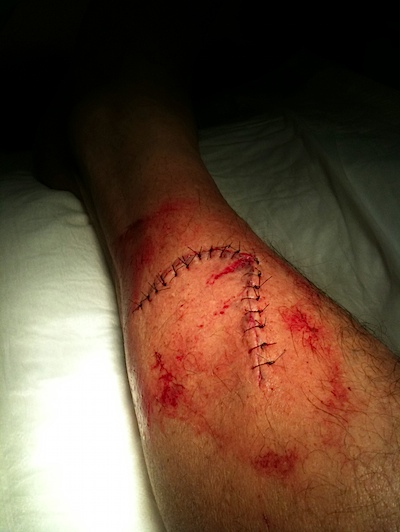
Wanna see the before?
To which I of course responded, “Well of course I want to see the before. And I want to hear the story!”
Chuck obliged, and sent me the story of what happened, along with photographs. I thought it was an interesting story, partially on its own merits, and partially because Chuck’s storytelling style is so incredibly different from mine.
As a result, I am going to do something a little different. I’m going to post his story, but I’m also going to add commentary in key places.
IMPORTANT NOTE: There are a couple of very graphic photos of Chuck’s injury here. If that kind of thing bothers you, you seriously should not read today’s post.
The Flapper
It was a beautiful day in the La Sal range above Moab. It was threatening to be 100º in Moab and we decided to head uphill. So we decided to do a ride up around 10-11K feet. It was spectacular, September 28th and the Aspens were going off.
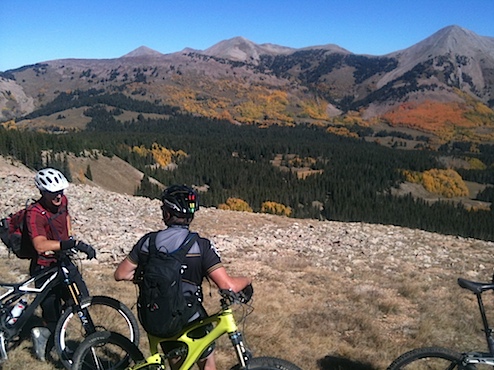
[Note from Fatty: So far Chuck and I are pretty much in alignment, though I definitely would have gone on for a few paragraphs about the lack of oxygen. And I probably also would have talked about how in spite of my lack of training I was managing to climb like a mountain goat on crack.]
It’s a hardcore ride, check out the hikeabike.
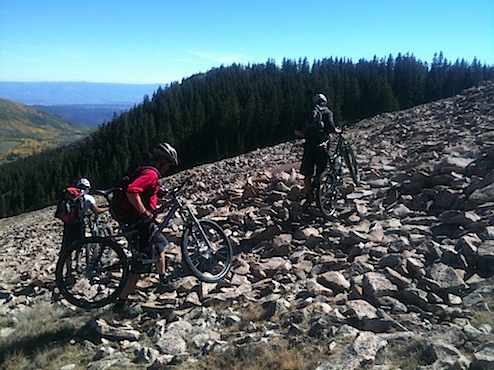
[Note from Fatty: OK, I would never just say "it's a hardcore ride," as if it were a throwaway clause. If I'm on a hardcore ride, I'm going to make it the centerpiece of the story. I'm going to go into detail about how hard it was, and exactly what was in the core, and then somehow manage to be both boastful and self-deprecating at the same time about how I managed to ride something that I wouldn't have thought I could. I probably would also have spent about 300 words describing what was going through my head as I pushed my bike across those rocks.]
But again the views were spectacular.
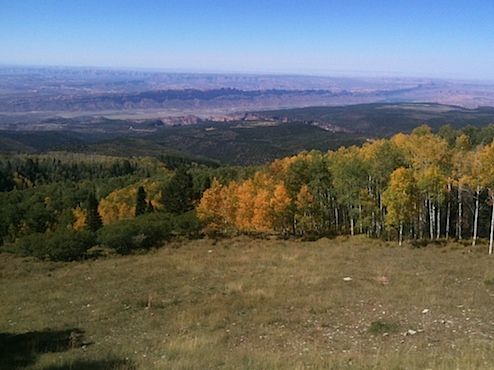
After a while, I ran into a low branch with my leg. Simple as that. Probably enjoying the view or something. I was with an experienced guide from Western Spirit Cycling, and he said it was the largest laceration he’s ever seen in 10 years of guiding.
[Note from Fatty: Frankly, I just can't even comprehend the beginning of that paragraph. You tore most of the skin off one of your calves, 'simple as that?' I would reconstruct the moment, millisecond by millisecond. I would describe the branch in such a way that would make women and children tremble. I would turn this story into a seven-parter, with the entire second part being about the exquisite pain I experienced at the moment of injury, the third part being about the pain I experienced during the next two minutes, and the fourth part being about how I passed out upon looking at the gory inside of my leg.]
SImon and I turned around, the other 6 went on. This is a very big epic ride. I was less than half way.
Rode back to town, 26 miles, with the “flapper.”
[Note from Fatty: If I were writing this story, part five would be called "Riding into town with the flapper," and it would be 1200 words long. ]
The rest of the images tell the story.
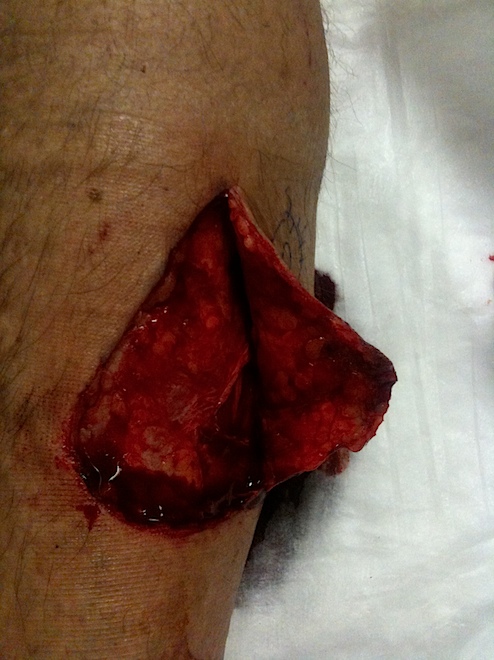
[Note from Fatty: I passed out for a moment, just looking at that thing.]
The nurse drew a smiley face on there for me.
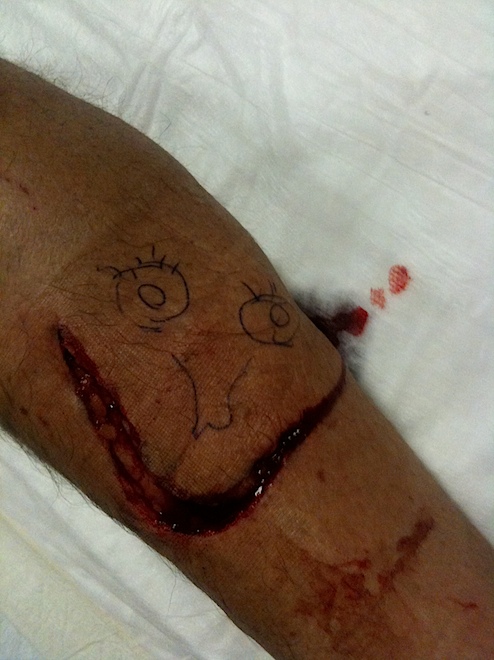
The ER doc was a magician with the stitches. I got 8 inside and 18 outside.
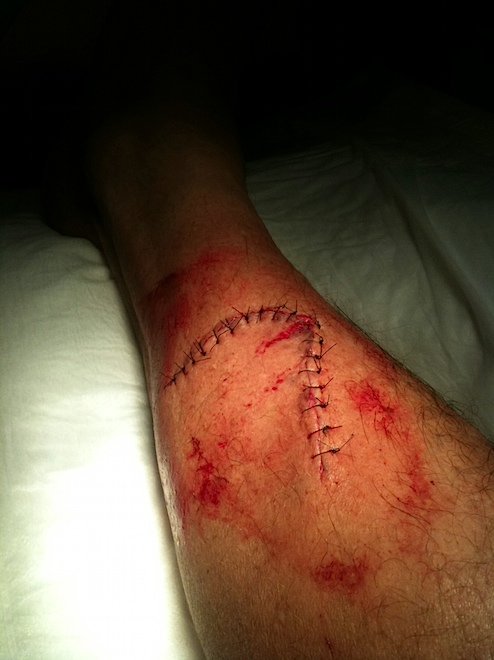
Yesterday we rode the Virgin River Rim Trail. Wow!
[Note from Fatty: I would make part 7 of this seven-parter be all about how I anguished over whether I would ever ride again, then how I made the heroic decision to go riding the next day and about how the pain was nearly unendurable, and yet I survived and am a better man for it.]
PS: Is anyone going to be driving from Santa Cruz to Santa Rosa next week? And if so, would you mind picking a road bike up and hauling it over for me? Chuck’s gonna loan me a sweet bike for Levi’s GranFondo, but we need to get it over there. Email me if you can help.
PPS: Don’t forget that today and tomorrow are the last days you can enter the Orbea Orca with Shimano Di2 / Ride for the Roses contest.
Comments (53)
09.29.2010 | 12:20 pm
A Note from Fatty: The “Win an Orbea Orca with Shimano Di2 or a Trip to Ride for the Roses” contest is in full swing, with more than $23,000 $24,000 raised on my Austin LiveStrong Challenge page alone. And together, the five Team Fatties (Seattle, San Jose, Philly, Austin, NYC) have raised $434,342 so far this year. That’s awesome, but we have more to do. So, if you haven’t donated yet, please donate now. You might win a dream bike or a trip to join Team Fatty at the Ride for the Roses. The contest ends this Friday, so don’t delay!
This is going to be one of those “exception proves the rule” posts. Or if it doesn’t prove it, it at least illustrates it. Or emphasizes it. Something like that. I don’t know. Regardless, I shall now tell my “exception does something with the rule” story.
Last week, I had one of those moments where an appointment falls through, no new one takes its place, and — lo and behold — I happen to be near a mountain bike trail and have all my biking stuff nearby.
It was, essentially, one of those moments that give serendipity a good name.
Not wanting to tempt fate — which loves to fill my time with non-biking activities — I suited up, texted The Runner that I was “going to do a quick Hog Hollow” (a “quick” ride means, in this case, not that I would be riding quickly, but that I would be doing so immediately and would be back before she got home from work and therefore do not expect to have any brownie points deducted from my stash of accrued brownie points, if in fact I currently have any brownie points accrued).
Then I put my phone in my jersey pocket and was gone.
It was one of those rides that reminds me of why I love Autumn so much. The weather was cool, but not cold. The colors were changing. A brief-but-hard-rain the evening before had packed down the singletrack, making it grippy and fun.
Although, I noted, that same rain also washed some scree into new rows and piles on the Hog Hollow climb itself. (That’s foreshadowing, by the way.)
After about an hour (or so, I wasn’t counting) of excellence on Corner Canyon (Jacob’s Ladder to Ghost to Canyon Hollow to Rush to Clarks, for those of you who are locals), I began my descent from the saddle of Corner Canyon down Hog Hollow, heading home.
And then, about halfway down, I hit one of those new piles of scree. My front wheel washed out to the right and I went down on my left knee.
For those who have ridden with me when I’ve taken a fall and are therefore wondering: No, I did not scream. I only do that when others are around. As far as you know.
Instead, I stood up to start riding again.
Then I sat back down, as the wave of nausea hit.
I took a look at my knee. It didn’t look beautiful. It looked, in fact, as if someone had taken a rather jagged ice cream scooper to my knee and scooped off a deep, ragged chunk of skin.
I should’ve taken a picture. Really, I should have. Here’s one now — six days later — but it doesn’t really give you the full effect.
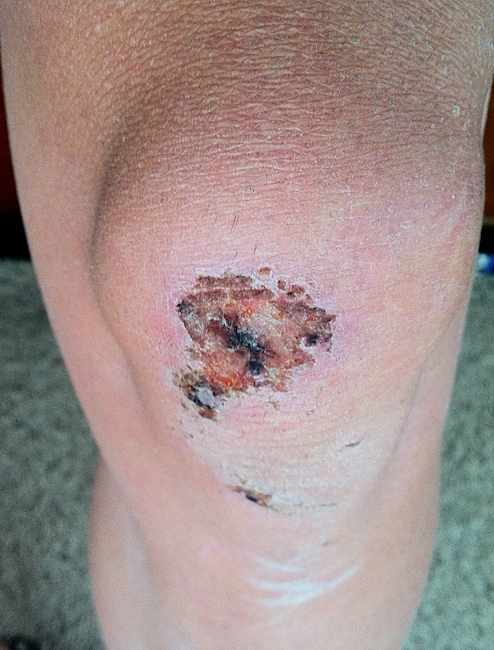
So as I sat there, waiting for the pain to subside, I had a couple of thoughts:
- Really, all things considered, it’s amazing I get hurt only once in a while.
- I wanted to call Lisa and see if she would give me some sympathy over the phone.
So I called The Runner (I know, sometimes I call her Lisa, sometimes I call her The Runner; I don’t know why) and negotiated the tricky conversational waters of trying to get sympathy while still coming off as a tough guy, not as a crybaby.
I think I might have come off more on the crybaby side, if I’m were to be completely honest with myself. Which I’m not.
But I did get my sympathy, and that’s what counts.
Conditioned Reflexes
Later, after the oh-so-fun session of scrubbing and bandaging the knee, I spent a little bit of time thinking about the first observation I had had while staring and my new injury: it’s really amazing that — considering we ride fast on pavement or dirt and rocks and stuff — that cyclists really don’t crash very often.
And then I started thinking about the “why” of this, and I realized there are quite a few conditioned reflexes I use as a cyclist that I generally now take for granted. And chances are, you do to.
So I started to think about them:
- Balancing: The very first conditioned reflex a cyclist learns is the act of remaining upright on a bike. When I think about it, it’s still amazing and crazily unintuitive: you’re straddling a tangle of bars and wheels, with only a couple-inch-square pair of rubber patches touching the ground at any point. And yet, you stay upright. And after a while, you stop even thinking about how you stay upright. You’re on a bike, riding along. Why wouldn’t you be upright?
- Leaning: If I were asked how I steer my bike, I’d be tempted to say “with my handlebars.” But the truth is, except for at low speed, the the handlebars have almost nothing to do with it. You steer your bike by leaning. How much? How far? And to what degree in concert with a nudge against the handlebars? I couldn’t even explain. The truth is, I just look at a place and ride my bike toward it, with no conscious thought whatsoever about the complicated stew of balancing, steering and leaning my body is executing. And that’s for the best, I think, because if I had to make all those actions consciously, I’d almost certainly fall down.
- Pedaling: Pedaling is like breathing. It can be conscious, where you think about every single stroke. But when you’re just cruising along, your legs just repeat the motion, endlessly and tirelessly. Until, of course, they don’t.
- Shifting: I remember when I would have to think so hard about my front and rear derailleurs and the cogs up front and back and how pushing on one lever with my left hand to put the chain on a bigger gear would make pedaling harder, but pushing on a similar lever with my right hand to put the chain on a bigger gear would make pedaling harder. And I’d get so boggled. Plus there were the concerns about cross-chaining and mis-shifting. Now I don’t even think about shifting (and not just because I often ride a singlespeed, wise guy). When I’m climbing I — without even thinking about it — go to a gear for climbing. When I’m on the flats, I’m in a bigger gear. Without ever cross-chaining.
- Braking: Sure, I consciously know the left hand lever is for my front brake and the right hand lever is for my back brake, and that most of my power is in the front brake but I shouldn’t lock it up or I’ll fly over the front. But when it comes time to stop or slow down, I just squeeze. Both hands a little different, both hands the right amount.
- Not Braking: I’m really proud of this one. I’ve noticed several times in the past years that when I hit a loose spot or otherwise start to skid in a turn that I no longer grab more brake. Instead, I release the brakes. Without even thinking about how locked wheels don’t steer at all and if I want to not skid off the road, my wheels need to be turning. I just — now intuitively — do what was once upon a time incredibly counterintuitive: when losing control, I release the brakes.
- Unclipping: Everyone pays for this conditioned reflex by falling over, still attached to the bike, at least once or twice. But now what was once a strange, unnatural action — twist your heel out if you want to get your foot off the pedal — is the most normal, natural motion in the world. A total, complete reflexive action.
And of course, my problem is that I have just the barebones set of cyclist conditioned reflexes. Someone with really great technical cycling skills would be able to tell you about others — dropping ledges, riding a wheelie, not falling down when they hit a pile of scree.
But hey, it’s nice to know the right half of my brain is doing at least some of the work.
PS: I recently posted about Ride the Divide, and even more recently got my own special Team Fatty Edition of the movie. Mike tells me there are more copies available. Click here for details and order yours today.
PPS: Did you know that before I started posting on fatcyclist.com, I posted this blog for a year and a half using MSN Spaces? Well, Microsoft recently announced that they’re canceling Spaces and made it easy to import all your Spaces content to WordPress. Which I did. The practical upshot is that my entire blog, from the first post on May 9, 2005, is now on this site.
Comments (31)
09.24.2010 | 9:40 am
About a year ago, Dustin at Shimano helped me give away a mind-boggling road bike to help Team Fatty raise money for our fight against cancer.
An Orbea Orca, equipped with the new outrageous technological marvel from Shimano: Dura-Ace Di2: the electronic shifting group. Not to mention Dura-Ace carbon tubeless wheels and PRO components.
A dream bike’s dream bike. Easily worth around $10,000.
And then, after the contest, Dustin did me another huge favor: he helped me get the exact same bike for myself.
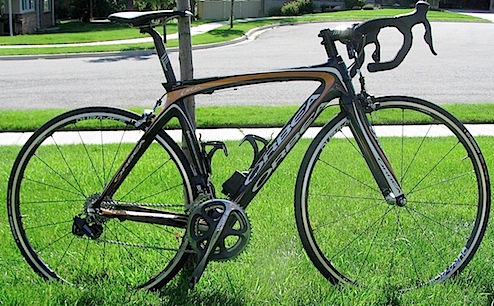
And now, after having ridden this bike for a year, I have no problem whatsoever saying that I am totally, hopelessly elatedly in love with both the Orbea Orca and the incredible — yes, I mean incredible — Di2 shifting group.
And I’m giddy that I get to announce that — in the name of our fight against cancer — we are going to once again have a contest to win this bike.
But this time, it’s the new 2011 version:
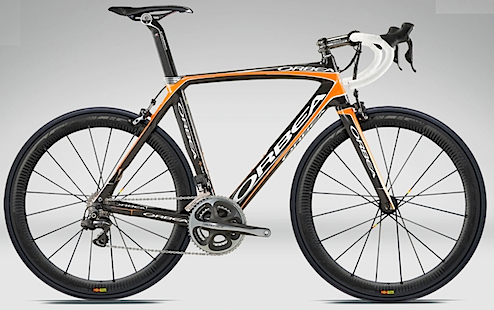
That’ right. You can win the beautiful, strong, light (I’ll talk about each of these adjectives in a minute) 2011 Orbea Orca, outfitted with the most incredible set of components imaginable, all by joining Team Fatty in our fight against cancer. Read on to find out how, or just head on over to my LiveStrong Challenge Page to enter now.
And that’s not the only reason you should enter. Because — get this — thanks to my good friends at Twin Six, I’m also giving away a trip for two to Austin to join me and the rest of Team Fatty for the Ride for the Roses.
But first, I’m going to tell you about why I love my own Orbea Orca with Shimano Dura-Ace Di2.
What I Love About the Orca
I don’t even know how many times people have stopped me to just ogle my Orbea Orca (check out some photos here).
It’s just a gorgeous bike. Sculpted without getting wacky. Functional and elegant.
It’s a joy to look at, frankly.
But it’s not simply a looker. The front end is unlike anything i have ever experienced on a bike. never realized how stiff a bike’s front end could be until I rode the Orca for the first time.
And I have never been so fast on the road as I am on this bike. I am a faster climber. Part of that’s because this bike is easy to build at under 16 pounds. More importantly, though, power transfer with the Orca is amazing.
And on the descents, I am faster than ever before. This bike makes me feel stable and confident.
Of course, these things are all true for the 2010 edition of the bike, which is what I own. For 2011 — the bike we’ll be giving away with this contest — the Orca keeps the stiffness I love, but gains smoothness. It’s more aerodynamic, and the winner will get a special version of the frame with internal routing.
Oh, and did I mention it’s going to be beautiful? Cuz it is.
What I Love About Shimano Di2
Electronic shifting. People who haven’t tried it are often quick to dismiss it. After all, non-electrong shifting works just fine, right? So why would you need or want the Shimano Di2 group?
People who have actually ridden and lived with the Di2 group, on the other hand, don’t ask that question. Here are some of my takeaways from my experience with riding with Dura-Ace Di2:
- Shifting is practically effortless. A quick tap of the right buttons — which are placed so as to feel perfectly natural to those of us who are used to traditional shifting — makes the gear change. Perfectly. Every time. Ever since messing up my left wrist a few years ago, going to the big ring with old shifters hurts. And for anyone, if you don’t make the shift throw correctly, you’re likely to drop your chain. I have never ever dropped the chain with Di2. Perfect shifts every time.
- Shifting is so fast and perfect. I can go up and down the cassette at crazy speeds with Di2, and I can move from the small to big ring (and back again) in no time at all. And I can do it no matter what the gradient is or how much stress I’m putting on the pedals. Shifting is in service to me, instead of the other way around.
- Shifting is maintenance-free. You’d think that electronic shifting would require more hassle on my part, but the reverse has been true. I have had to do no maintenance of the Di2 system. Cable stretch is not a problem. The derailleurs never get out of alignment — they shift as crisply and perfectly now as on day 1. It’s just amazing.
- Auto-trim is awesome. When you shift — front or rear — the front derailleur makes instant, tiny adjustments to keep the chain perfectly aligned. It’s brilliant.
- The battery lasts for months. I was initially worried that I’d have to charge the battery every couple of rides. Or at least once a week. But even with several rides per week, I only have to charge the battery every few months. I wish my phone would go that long between charges.
- I love the R2D2 sound. When you shift, you get a cool “bwwwrp-zzp” sound as the motors move the derailleurs. I love this sound so much I sometimes shift just to hear it. Really.
I should also mention that I also love the Shimano Dura-Ace Carbon Tubeless wheels. So light. So fast. And since I only have to inflate them to 80psi, the comfort on the road — not to mention handling — is just off the charts.
Honestly, this bike is just perfect. It’s like nothing I’ve ever owned.
And now, if you help out Team Fatty as we raise money for the fight against cancer, you have a chance at winning one for yourself.
Specifically — and I’m going to go with bold for the rest of this paragraph — you will get a 2011 Orbea Orca, outfitted with the Shimano Dura-Ace Di2 group, Dura-Ace Wheels, and an a full complement of PRO components. A bike which would retail for between $10,000 and $12,000.
Wow.
How You Can Win
Oh, you think you’d like to have this bike? Well, of course you would. Well, to win it, you’re going to need to do a little cancer fighting with me. Here are the ways you can donate.
- By Donating at my Austin LiveStrong Challenge Page: For every $5 you donate at my LiveStrong Challenge page, you get another row on my spreadsheet. That DOES NOT mean that if you want to donate $50, you’ve got to do ten $5.00 donations. I’m awesome at Excel and will be able to give you the correct number of chances automatically, based on how much you donate. Click here to donate now .
- By Raising Money at Your OWN Team Fatty LiveStrong Challenge Page: If you’re a member of Team Fatty, now’s a great time to donate money to your own LiveStrong Challenge, as well as to get others to donate to it. For every $5 you raise between the beginning of the year to the end of the contest, you get another chance at this bike.
The contest ends Friday, October 1, at Midnight, MDT. At that point I will choose a winner at random from my spreadsheet, using random.org to pick the lucky person. I will then fire off an email to the winner. Once I get acknowledgement, I’ll announce it on my blog, and you can begin collecting envious looks.
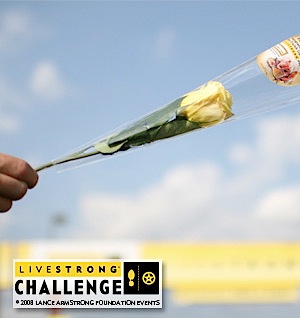 You Can Also Win a Trip to Austin to Join Team Fatty for the Ride for the Roses
You Can Also Win a Trip to Austin to Join Team Fatty for the Ride for the Roses
As if winning a $10,000 bike isn’t enough, I now have another grand prize with this contest. Some lucky person who donates at my LiveStrong Challenge page will win a trip for two to the Ride for the Roses. You will be treated at the “yellow jersey” level, getting:
- Airfare (within the US) for the two of you
- 3-night hotel stay
- Sunday ride front starting line position
- Ride for the roses jacket and jersey
- Access to the Sunday hospitality tent
And you’ll — most importantly — get to hang out with the rest of Team Fatty at this event.
How am I able to give away this prize? Simple: my good friends at Twin Six are giving up their hard-earned spots. They say that they got to go last year and now they want to give that opportunity to someone else.
Honestly, these are the nicest guys in the world.
Donate Now
With an amazing bike and an amazing trip as grand prizes, this is a huge contest. And a couple of lucky people are going to get these incredible prizes.
But, chances are, you won’t win. And that’s totally fine. Because — whether you win or not — you will have contributed money to LiveStrong, and you’ll have helped in the fight against cancer. And that matters.
So, head to my LiveStrong Challenge page and donate. Or join Team Fatty and start raising money on your own LiveStrong Challenge page. Either way is a great way to win, and a meaningful way to help in the fight against cancer.
Good luck!
Comments (57)
09.24.2010 | 7:21 am
I’d like to kick this weekend off by posing a couple of questions. These questions are real philosophical humdingers. These are questions that are going to make you tug at your beard (whether you have one or not) and gaze — unfocused — into the sky.
These are questions that — with any luck — will compel you to write clever responses in the comments section.
In order for you to understand and answer these questions, you must first look at this photograph (click to see a larger version):
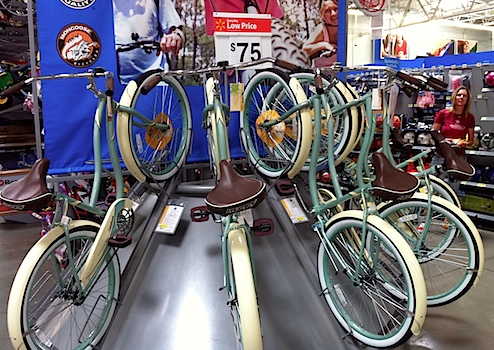
Now, before I get to my questions, I’d like to point out some important facts you’ll need:
- These bikes are new.
- These bikes are at Walmart.
- These bikes cost $75, each.
- That’s The Runner at the far right side of the picture, wondering why I’m taking a photograph of these bikes.
The Big Questions
So now, armed with the knowledge you need, I would like you to now consider and then respond to the following questions:
- As with anything, the law of diminishing returns applies to bicycle purchases; a $30,000 bike is (probably?) not going to be three times as awesome as a $10,000 bike. But does that law apply in the opposite direction? Which is to say, is a $75 bike only going to be 1% as fun to ride as a $7500 bike? Explain your answer.
- Which would give you more trouble-free hours on a bike: buying one $7500 bike, or buying a hundred $75 bikes (i.e., when one $75 bike breaks you walk away from it and get out the next one)? I’m genuinely interested in your answer on this one.)
- Which would be the more awesome spectacle: one person riding a $7500 bike down the road, or a procession of a hundred people riding identical $75 bikes down the road? This question is mostly rhetorical.
- If we take for granted that a $75 bike is not suitable for most traditional cycling purposes (e.g., going somewhere), what are suitable purposes for $75 bikes? Be creative.
I anticipate your answers with great anticipation.
Comments (129)
09.23.2010 | 12:25 pm
Today is my third installment in my “Stuff Fatty Loves” series, wherein I talk about bike-related things I can, without reservation, recommend. And I am pleased — no, delighted — to announce that today’s lovable thing is soft serve ice cream.
What? You wonder how soft serve ice cream is a bike-related item? Well, to you I say: pffff. There’s nothing in the world more bike-related than soft serve. Except perhaps a bike. But my point stands. Or it will stand, after I prop it up a bit.
Which I will do right now. In a roundabout way.
Lucky Accident
I live in Alpine, Utah, about as close to American Fork Canyon as you can without actually taking up residence in the little toll booth at the mouth of the canyon. This is not by accident, because I knew before I moved here exactly how perfectly suited to both road and mountain biking American Fork Canyon is.
However, I did not consider when moving here that American Fork Canyon is also home to the Timpanogos Cave National Monument.
But if I had considered that, I would have wanted to move here even more. Because the Timp Cave Visitor Center — which you must pass, whether you’re mountain biking or road riding — has a nice little concession stand.
And that concession stand has vanilla soft serve ice cream for sale. For $0.89, you can, on the way home from a mountain or road ride, get yourself a cool little coneful of heaven.
After you’ve been riding in the heat for hours, nothing in the world sounds quite so perfect as something cool, creamy, and caloric. You’re just sitting outside, relaxing in the shade, still near the mountain that you love, licking the ice cream fast enough to keep it from melting, but not so fast that it gives you an ice cream headache.
There have been times when, for the last half hour of a ride, all I can think about is that soft serve. Where I’ve been asking myself — with all the focus and intensity as if I’m considering the meaning of life — whether I’ve got a debit card or paper money with me. Or — failing that — whether I’ve got enough change in my vehicle to cover a cone.
The Beauty of Soft Serve
It’s possible you’re wondering what the big deal is. “It’s just ice cream,” you might claim. Or maybe even, “Soft serve isn’t even great ice cream — why get attached to soft serve in a world that contains Ben & Jerry’s New York Super Fudge Chunk?”
Those are reasonable objections. And my responses to those objections are really what makes soft serve ice cream a bike-related thing I love.
I shall enumerate. Using numerals and everything.
- Consistency. Soft serve is — this should come as no surprise — soft. Either during or after a ride, when I’m really cooked, ice cream that is already practically pre-melted for me is perfect. Hard ice cream is too much effort; I prefer to just lazily lick around the cone. Plus, because it isn’t as cold as regular ice cream, it doesn’t freeze your taste buds. Which means you taste it better.
- The other consistency. No matter where you get it, soft serve is pretty much the same thing. No weird surprises. You can be riding anywhere, stop at an unfamiliar place and get a soft serve cone and be certain it’s going to be what you want.
- Near-ubiquity. Chances are, if you go riding past any fast food restaurant, you’ve got access to soft serve.
- The cone. Soft serve generally comes in a cake-style cone — the whiteish, flat-bottomed cones. I love these cones as much as the ice cream itself.
- The ritual. Everyone eats their soft serve in their own particular way, and I’m not here to judge your way. The important thing is, everyone really does eat their soft serve in their own way — the same way — every single time, and it’s a magnificent expression of self. As for myself — I know you’re curious — I go for sideways licks, spiraling from the top to the bottom of the cone, rotating the cone as I go, and always monitoring for drips onto the cone itself. Once I have gotten the ice cream perfectly level with the cone, I bite away the first level of the cone, then repeat the original process. Once the ice cream is level with the remainder of the cone, I bite off the top half. I then pop the bottom half into my mouth.
- Time. A soft serve cone takes about five minutes to eat — just about the right amount of time for a ride break or to cool down after a ride.
Problem Areas
There are, sadly, some trouble spots with soft serve. The most important one for me is that my body has evidently decided that the primary purpose of dairy products is as a catalyst for fart production. I have resolved this problem to my satisfaction, however, by rationalizing to myself that as long as I have just one cone, my gassiness won’t be that bad.
Which I’m sure everyone agrees with wholeheartedly.
The next problem with soft serve is in quantity. Specifically, there are some ice cream servers who are too generous. Yes, I know it sounds weird, but I don’t like it when I buy a cone and get eight inches of ice cream towering precariously atop my cone. For one thing, that much ice cream is going to compound the gassiness problem. For another, the chances of my successfully eating that much soft serve without it becoming a melty mess is poor at best. And of course, the likelihood of the ice cream tower toppling from the cone is very high, which means I will — in a slow-motion split second — likely go from having too much ice cream to having too little.
Thus, I hereby declare that the correct dimensions for the soft serve above the cone are as follows:
- The diameter of the ice cream shall not exceed the diameter of the widest point of the cone by more than 1/2″. Nor shall it be any narrower than the widest point of the cone.
- The height of the ice cream shall be the same height as the cone itself, plus or minus 1/2″. Thus giving the soft serve cone a pleasing symmetry.
I do not, by the way, want to come off as some bourgeois soft serve snob; I fully recognize that serving a well-balanced soft serve cone takes talent and practice. Seeing a well-formed cone always makes me envious; any attempts I have ever made at serving soft serve have been miserable failures.
Vanilla vs. Chocolate vs. Twist
Most soft serve machines have three options: chocolate, vanilla, and twist (ie, a combination of chocolate and vanilla).
Allow me to recommend that — even if you really like chocolate — you always go with straight-up vanilla. I say this because while the vanilla flavor is in fact very vanilla, the chocolate flavor is not really very chocolate-y.
And buying twist just means that you’re wishy-washy and indecisive. Don’t buy twist.
Wrapping Up
In conclusion, I love soft serve ice cream, and am satisfied that I have managed to — somewhat weakly perhaps — tie it to cycling.
Comments (50)
« Previous Entries Next Page »











 You Can Also Win a Trip to Austin to Join Team Fatty for the Ride for the Roses
You Can Also Win a Trip to Austin to Join Team Fatty for the Ride for the Roses